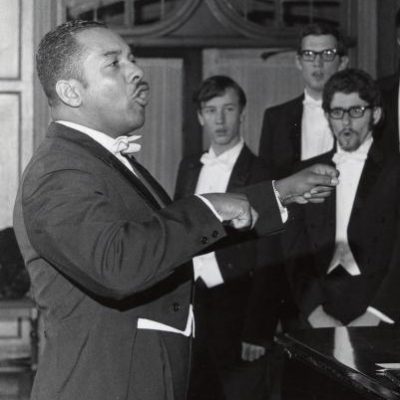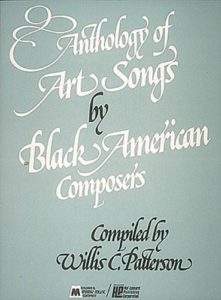Willis Patterson: Artist and Advocate
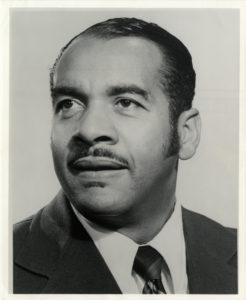
Courtesy of the E. Azalia Hackley Collection of African Americans in the Performing Arts, Detroit Public Library.
The 2018-2019 academic year marks the 50th anniversary of the racial integration of the University of Michigan School of Music, Theatre & Dance (SMTD) faculty with the hiring of black bass singer Willis C. Patterson to the Department of Voice in fall 1968. For the School’s administration, this was perhaps a safe choice for their first foray into the modernizing world: a native of Ann Arbor, Patterson had completed two degrees at what was then the School of Music, and had started work on a third. He was an experienced performer and teacher, with enough qualifications to be hired as a tenured associate professor. And he was known to the faculty, who were thrilled to welcome him back to his alma mater. Even so, Patterson was also a fortuitous choice for a School facing increasing pressure to raise the proportion of its students and faculty of color. Over his more than 30 years on the faculty, including 20 years as associate dean, Patterson arguably did more to advance the cause of racial equity at SMTD than anyone else in its history, before or since. In addition to being a tireless advocate for the School’s community of color, he also made enormous strides in promoting the inclusion of music by African Americans in the traditional vocal canon. On this golden anniversary of his return to Ann Arbor, we celebrate the contributions of Dean Willis C. Patterson.
From Humble Beginnings to the World Stage
Born in 1930 at the height of the Great Depression, in the impoverished and mostly segregated (in fact if not in law) black community in Ann Arbor, to a father married to a different woman and a single mother who would soon wed an alcoholic and abusive stepfather, Patterson had none of the childhood advantages that would suggest his eventual success. He began working odd jobs from the age of nine, left home and supported himself from age 14, and entered the Air Force at 19 knowing that the G.I. Bill would be the only way he could afford higher education. Despite the many hardships, Patterson’s childhood was buoyed by a community of relatives, friends, teachers, and others who saw his potential and encouraged him to pursue his passion for singing.
Returning from the service in 1952, Patterson enrolled at what is now Eastern Michigan University for two years before transferring to the U-M School of Music to finish his undergraduate degree. In his autobiography, Patterson speaks of the difficulties he experienced at the collegiate level due to his lack of previous formal training: he could barely read music and needed remedial instruction to pass the required piano courses. But he had natural vocal talent, an ear for languages, and—in part because he was older than traditional college students after three years in the service—the strongest bass voice at both institutions. He quickly earned solos in choir performances and leading roles in operas. By the time he had finished his master’s degree from U-M in 1959, Patterson had erased all traces of his under-resourced childhood from his abilities as a musician.
Patterson spent the next two years on the faculty of Southern University, a historically black institution in Baton Rouge, Louisiana. He attributes to that period in his life enormous growth in his abilities as a vocal instructor and choir conductor. Being surrounded by other black musicians and professors also strengthened his awareness of his African-American heritage and the enormous social changes that were underway in the early 1960s. He returned to Ann Arbor in 1961 and enrolled in the DMA program at the School of Music, but after a year was lured away by the offer of another professorship at a HBCU (historically black college or university), this time at Virginia State College (VSC) in Petersburg, Virginia.
For the next six fruitful years at VSC, Patterson found much success as a professor, but also as a performer, appearing in concerts and recitals across the eastern part of the United States. In 1963, when he heard that NBC television would be recording a new version of Menotti’s opera Amahl and the Night Visitors to air during the Christmas season, Patterson wrote to the station to protest the customary racist practice of casting a white man in blackface to sing the bass role of Balthazar. He suggested several black performers capable of filling the role, and included himself on the list since he had already performed the part several times. NBC, to their credit, decided to follow Patterson’s advice and invited him to New York to audition alongside several other black bass singers. Patterson ended up winning the role, and the re-airing of the production every December for the next three years helped to increase his profile as a performer.
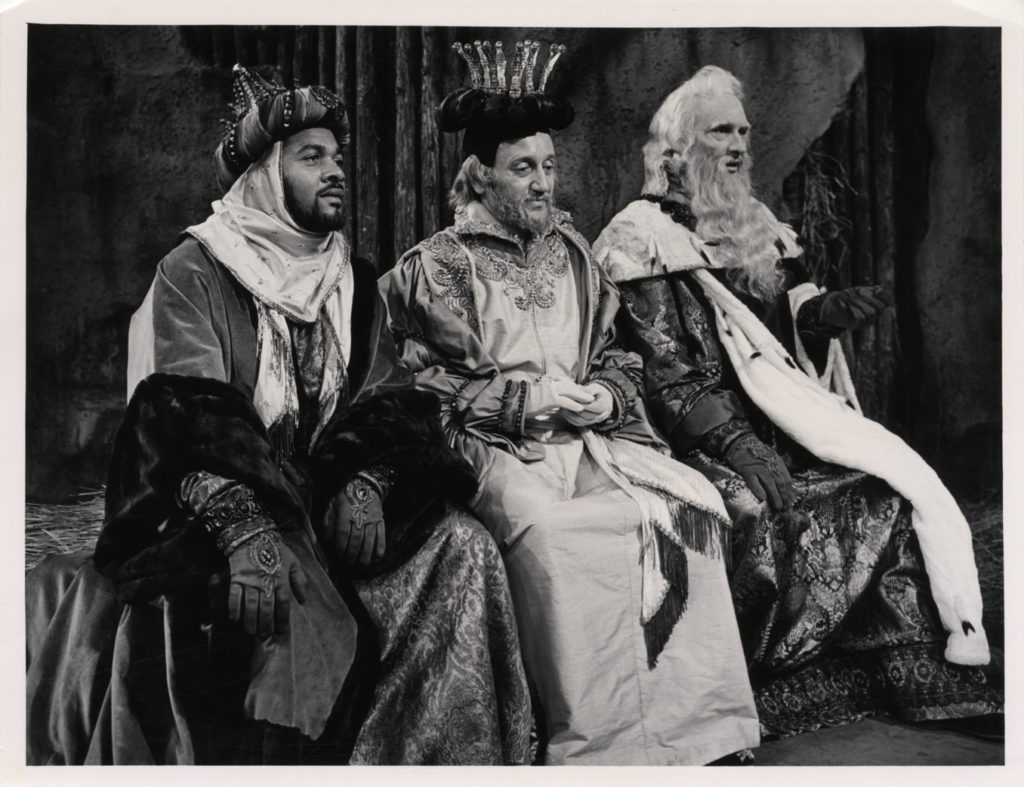
Willis Patterson, John McCollum and Richard Cross in Amahl and the Night Visitors, NBC Opera, 1963. Collection of African Americans in the Performing Arts, Detroit Public Library.
Two years later, Patterson won a Fulbright Fellowship to study German Lieder (art songs) at the Staatlische Hochschule fur Musik in Freiburg, West Germany during the 1965-66 academic year. While there, he performed to much acclaim in operas and concerts across Europe. Returning to VSC for the next two years, Patterson recalls that he finally felt settled, productive, and happy with his lot. But of course, all of that was about to change.
Making the Most of Michigan
The decision to leave the comfortable confines of VSC for the University of Michigan was a difficult one for Patterson and his wife Frankie. His career had flourished in Petersburg with the support of his circle of African-American colleagues and friends, and he recounts feeling guilty at the prospect of participating in the “brain drain” caused by majority institutions intent on integrating their faculties by luring scholars of color away from HBCUs—in less enlightened times, the only places they could find employment as university professors. On the other hand, he had grown up idolizing U-M students and faculty, and the prospect of permanently joining their ranks was enticing. In the end, he says, the decision to return to Ann Arbor was a more personal one: though he and Frankie were happily ensconced in the bubble of VSC where nearly everyone was black, their three young children would eventually need to attend Virginia public schools that had only recently been integrated and which were still largely white. At Michigan, Patterson himself would be the lone black professor at the School of Music, but at least his children would have an easier time in a more inclusive school environment. So it was that Patterson accepted the offer from U-M and moved his family to Ann Arbor in the summer of 1968.
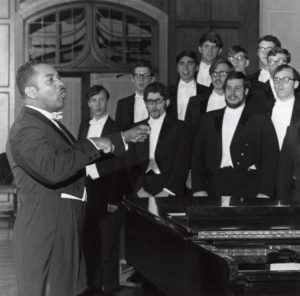
Willis Patterson conducting the Men’s Glee Club, 1970. Courtesy of the University of Michigan Library Digital Collections.
From his earliest days at Michigan, Patterson experienced the tension common to so many professionals of color, even today: the desire to avoid becoming a “token” or being pigeonholed as “the black person,” while also not denying their heritage or community. For Patterson, this tension manifested in his strong desire to prove himself worthy of a professorship at an elite institution like U-M. “I felt myself constantly needing to ‘leave no stone unturned’ in the quest to prove myself equal to and deserving of my status among my white peers,” he later wrote. Over the next decades Patterson pursued an exhausting schedule of concerts, operas, and recitals to buoy his national reputation as a singer of the traditional canon of European classical music. At Michigan he trained countless students in the same repertoire, and for six years served as the director of the Men’s Glee Club. His desire to prove himself among his peers was validated in 1975, when he was appointed chair of the Department of Voice with the “unanimous and enthusiastic support” of his colleagues.
Even as he achieved success in dimensions mostly unrelated to his race, Patterson found himself in a unique position to push for further integration at the School of Music. As a native Ann Arborite he was deeply familiar with the communities of color in the city and its surrounds, and as a past professor at two HBCUs he was also tapped into the expansive network of black music professors across the country. From the moment he was hired at U-M until his retirement in 1999, Patterson was a tireless recruiter for students of color. He and two black colleagues from other U-M units toured high schools in Ann Arbor, Ypsilanti, Detroit, and other communities to encourage talented students to apply to Michigan. He also carried on correspondence with prospective undergraduate and graduate students from across the country and in every music field, from voice to oboe performance. In the days before the internet, he served as the primary means by which students of color learned about the opportunities available to them at the School of Music—and in particular, the special “minority fellowships” that could eliminate a major impediment to many students of color who aspired to attend the University. In addition to his active recruitment, Patterson’s very inclusion on the faculty served as a beacon to many prospective students. “The fact of my presence, as a full time member of color… on the university instructional staff, served as a strong attraction and incentive to African-American students from the state of Michigan, as well as from other states,” he explains. His continual vow, which he admits was “very ambitious and somewhat presumptuous,” was to make the University more relevant in the lives of communities of color, and in so doing, to contribute to its mission of service to the state.
Patterson received a good deal of support from the School of Music in his recruitment efforts, in part because of the changing tenor of race relations on campus. The first Black Action Movement (BAM) in 1970, including a student strike that closed the University for 18 days and made national headlines, led to a pledge by U-M president Robben Fleming to increase black enrollment to 10% of the student body by 1973. Patterson became an embodiment of that pledge at the School of Music, even though—like the University as a whole—he fell short of the 10% goal. In addition to instituting “minority fellowships” to fund students’ education, the School also permitted Patterson to create new preparatory classes during the summer session at the National Music Camp in Interlochen, Michigan. These courses helped students of color who were under-prepared because of their previous financial circumstances gain needed skills and knowledge before officially matriculating at the University. In this way, Patterson was able to dispel many of the doubts felt by some of his colleagues that black students would never achieve the necessary preparation to attend U-M. Patterson’s central role in recruitment was codified in 1979, when incoming dean Paul Boylan appointed him associate dean for undergraduate studies and minority affairs—a post that he would retain until his retirement in 1999.
Louise Toppin (DMA ’90), now a faculty member at SMTD, recalls that by the time she attended U-M in the late 1980s, SMTD had a reputation as a place that was completely welcoming to students of color. There was a large and robust community of faculty and students that helped each other navigate the University, and that largely centered around “Dean Patterson” and his office. At that time, SMTD had the largest number of DMA and PhD students of color in the country, and most of them succeeded in getting jobs at majority institutions after graduation. For Toppin, who had been the only black student at the schools where she earned her bachelor’s and master’s degrees, this was a revelation—and she knows many other students felt the same way.
In addition to his work at U-M, Patterson also ensured that underserved children from Ann Arbor and its surrounding areas would have the same chances to succeed that he did. In 1968 he founded Our Own Thing (OOT) to provide music instruction, instrument rentals, and scholarships; in the ensuing decades more than 1,000 youngsters have benefitted from these programs. An outgrowth of the program was the Willis Patterson Our Own Thing Chorale, an adult choir dedicated to performing traditional spirituals and new music by African-American composers. In 2018, current SMTD students were awarded a $10,000 EXCEL Prize to partner with OOT and provide piano instruction, practice keyboards, and guest artist workshops to students from Ypsilanti. They sought to address the lack of diversity and representation in classical piano by emphasizing the rich history of African-American contributions to the field.
Expanding the Canon
Patterson coupled his enthusiastic support for black musicians in the academy with his career-long promotion of music by black composers in the academic canon—though this project, too, was not without its tensions. Patterson had felt a certain level of ambivalence about so-called “black music” since his days in Germany as a Fulbright scholar, when a German critic had complained that rather than singing German songs to Germans who had certainly heard better versions from their own countrymen, he should be singing the music of his own racial and national heritage. “One of the main inner driving forces for my desire to become a highly competent singer of the standard art songs of Western world music culture was so that I might not be relegated to being known primarily as a singer highly respected for singing songs of my racial origin—Negro Spirituals. … I feared that my reputation might be marginalized to that of an acceptable singer of songs of my race,” he explains. At the same time, he did not want to completely reject his heritage or his uniqueness as a performer. It was then that Patterson began to discover the deep catalog of art songs written by African-American composers—not spirituals based on traditional melodies and themes, but wholly new compositions that set poetry to music, often drawing from the works of luminaries like Langston Hughes.
The word “catalog” is perhaps a misnomer, because there existed no easy way to locate this music. Patterson began amassing a manuscript collection that he obtained through personal connections with the composers, their heirs, and fellow black music professors across the country. Over the next 10 years, this collection swelled to more than 250 individual works. It was then that Patterson began to think seriously about publishing part of his collection in order to share these songs with the world. “One of the obvious results of this published compilation,” he wrote in a 1975 grant application, “would be to provide a resource not now available for performers and teachers, as well as to preserve a body of important music literature which might conceivably otherwise be lost.” Upon receiving funding from the University of Michigan, Patterson began a more concerted effort to collect additional art songs, traveling around the country and even commissioning works from black composers. When he finally sat down to pick the songs for his first anthology, Patterson had more than 500 possibilities from which to choose.
The road to publication was a difficult one for Patterson. After several rejected proposals he finally found a publisher willing to take on the project: Bernard Kalban at E.B. Marks Publishing Company in New York. However Patterson needed to scrounge up the considerable sum of $10,000 to fund the publication, which he only achieved through the largess of a patron who provided an interest-free loan. By all accounts his Anthology of Art Songs by Black American Composers, published in September 1977, was a huge success, but the subsequent volumes Patterson had planned never came to fruition. He managed to complete a second anthology only after his retirement, in 2002, by forming his own publishing company.
The fickle support of white society for projects by and for black musicians also manifested in the concert series Patterson planned during the 1977-78 academic year to accompany the release of his book. For that year, he was able to secure funding from the U-M Office of Student Services, the Office of Academic Affairs, the Affirmative Action Program, and even the Institute of Gerontology. “To this point the University of Michigan has been unable to do anything innovative in this particular area of heightening the Black experience and the contributions of Blacks to the cultural community, particularly in this fashion. Moreover, I don’t think anything quite like this has been done in the country to this point. As such, I think it would certainly distinguish the University in a special kind of way for the support of such a project and of such artists as these,” he wrote in his grant proposal. By this time the University had experienced the second protest of the Black Action Movement, in 1975, and the administration jumped at the chance to publically display their support for black scholars and artists. However when Patterson requested a second round of funding to continue his concert series in the next academic year, his proposals fell on deaf ears. It seems that these units saw his project as a one-time, out-of-the-ordinary occurrence, rather than the ongoing argument for inclusion that Patterson intended.
Nevertheless, within African-American academic circles, Patterson’s work was lauded for its important contributions to the canon. Patterson himself grew in stature as an academic, and in 1990 he was elected to serve as the president of the National Association of Negro Musicians (NANM), the country’s oldest professional association for black musicians. At SMTD, too, Patterson had success as an advocate for the expansion of the curriculum to reflect a wider range of composers and experiences. He instituted a course for voice majors to study music by African-American composers that Toppin still teaches today. “Nowhere else in the country is there a course like this taken by music majors,” Toppin says. “Many other schools just don’t make this a priority.” Even now, 20 years after his retirement, Patterson’s influence on the SMTD curriculum is still evident.
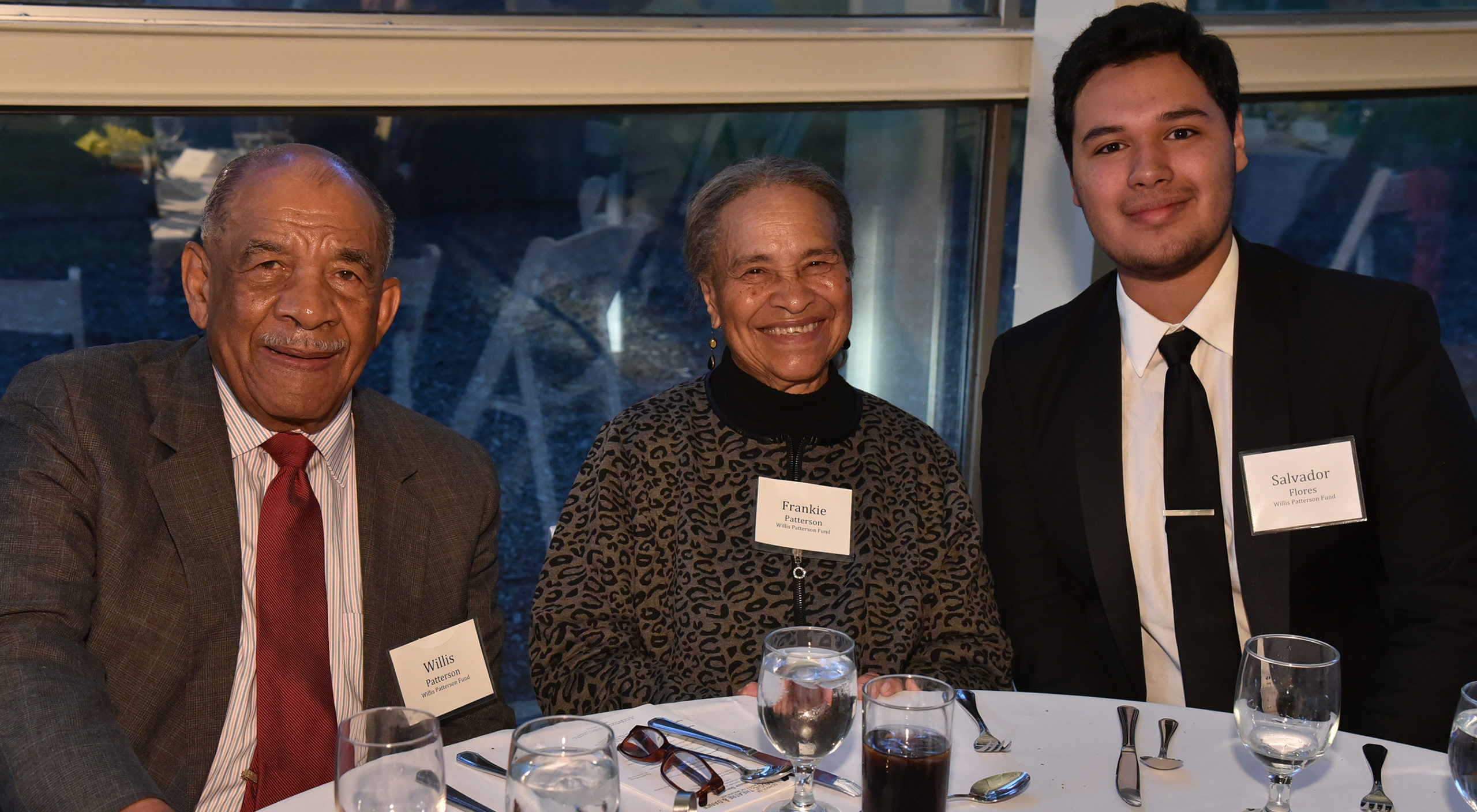
Willis Patterson and his wife Frankie at the 2018 Scholarship Showcase dinner with SMTD student Salvador Flores (BM ’21, saxophone). Flores is a recipient of a scholarship from the Willis Patterson Fund, endowed in 1998 by family, friends, and students in honor of Patterson’s retirement. Photo by Peter Smith.
Patterson was given an enormous opportunity when he was invited to join the faculty of the University of Michigan School of Music in 1968. But while others may have been comfortable to rest on their own successes, Patterson was not. He actively worked and fought to make sure the door wasn’t closed behind him, and that future generations of talented students and faculty of color could follow him to Ann Arbor. In his astonishingly varied career, Patterson was a performer, a teacher, a publisher, and an administrator. But above all, he was an advocate. When asked in an oral history interview what he valued most about his career, Patterson explained that he loved “being able to be used.” He owed much of his success to the generosity of others, especially when he was a child, and he felt that his purpose in life was to give back to anyone who might need him. And though he is long retired, every member of the SMTD community still benefits from the unparalleled service of Willis Patterson.
Learn More…
Louise Toppin’s students from the “African American Art Song” class will present two concerts of “Art Songs by African Diaspora Composers” on Friday, March 22 and Tuesday, April 16.
Patterson, Willis C. The Unlikely Saga of a Singer from Ann Arbor. Ann Arbor: Michigan Publishing, 2015.
Oral History: Willis Patterson. African American Cultural & Historical Museum and the Ann Arbor District Library. Recorded April 11, 2013.
Willis Patterson papers, 1952-1999. Bentley Historical Library, 2009161 Aa 2.

